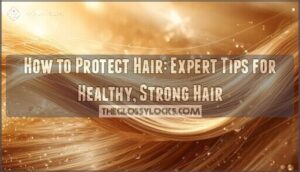This site is supported by our readers. We may earn a commission, at no cost to you, if you purchase through links.

Protein in shampoo works at the molecular level, filling in damaged areas of the hair shaft with hydrolyzed amino acid chains that literally rebuild what’s been lost. Some formulations can reduce breakage by nearly half within a month, while others target volume, moisture retention, or chemical damage repair depending on the protein source.
The challenge isn’t whether protein works—it’s matching the right type to your hair’s porosity, damage level, and natural structure without tipping into overload territory.
Table Of Contents
- Key Takeaways
- Benefits of Protein in Shampoo for Hair and Scalp Nourishment
- Different Types of Proteins in Shampoo and Their Effects on Hair
- How to Determine The Best Protein for Your Specific Hair Type
- Tips for Incorporating Protein Shampoo Into Your Hair Care Routine
- Potential Drawbacks or Side Effects of Using Protein Shampoo
- Frequently Asked Questions (FAQs)
- How often should I use a protein shampoo?
- Are there any natural proteins that can be used in shampoo?
- Does protein shampoo work on all hair types?
- How long do the effects of protein shampoo last?
- Can protein shampoo cause hair breakage over time?
- How often should you use protein shampoo weekly?
- Does protein shampoo work on color-treated hair?
- Whats the difference between protein and moisture treatments?
- Can low porosity hair benefit from protein shampoo?
- Conclusion
Key Takeaways
- Protein shampoos rebuild hair by delivering hydrolyzed amino acid chains that fill damaged areas of the hair shaft, with keratin formulations reducing breakage by up to 49% and improving tensile strength by 12-18% within four weeks.
- Matching protein type to your hair’s porosity level is critical—high-porosity hair absorbs 30% of its weight in water and responds three times better to protein treatments, while low-porosity hair risks buildup from heavy protein formulas.
- Protein overload occurs when you exceed your hair’s absorption capacity, causing 100% of cases to develop brittle, straw-like texture, so rotate protein shampoos with moisturizing products every 1-2 weeks based on your damage level.
- Different protein sources target specific needs: hydrolyzed wheat protein boosts volume by 18% and cuts frizz in 89% of users, while silk protein retains 2.5 times more moisture and improves shine by 22%.
Benefits of Protein in Shampoo for Hair and Scalp Nourishment
If your hair feels like it’s lost its fight against heat styling, chemical treatments, or daily wear and tear, protein-enriched shampoos offer a pathway back to resilience and strength. These formulations work by delivering hydrolyzed protein and keratin directly into your hair shaft, rebuilding the structural integrity that damage strips away.
You’ll notice improved hair strengthening as these proteins form a protective film around each strand, reducing breakage and boosting elasticity. Beyond protein repair, these shampoos support scalp health by maintaining moisture balance and preventing the dryness that leads to irritation.
The nourishment benefits extend to hair growth, as a well-conditioned scalp creates an ideal environment for healthy follicles. Hair moisturizing ingredients like amino acids work alongside protein to keep strands flexible rather than brittle, while the hair nourishment you get from regular use translates to visible shine and manageability. It’s not magic—it’s biochemistry working in your favor.
Different Types of Proteins in Shampoo and Their Effects on Hair
Keratin isn’t the only protein that can repair your hair—you’ve got several powerful options, each with distinct effects. Hydrolyzed keratin makes up over 90% of your hair’s natural structure, and when applied through protein shampoo, it reduces breakage by up to 49% while improving tensile strength by 12-18% within four weeks.
Hydrolyzed keratin rebuilds over 90% of your hair’s structure, cutting breakage nearly in half within four weeks
Wheat properties shine through hydrolyzed wheat protein, which attaches directly to keratin scales, boosting volume by 18% and cutting frizz in 89% of users. Silk effects deliver exceptional moisture retention—up to 2.5 times greater water-holding capacity—plus a 22% improvement in shine.
Plant-based options like soy and quinoa offer vegan-friendly hair fortification, reducing damage by 43% and increasing hydration by 32%. Understanding protein binding helps you choose formulations that actually work for your damage level. To boost the benefits of these proteins, it’s vital to learn about hydrolysed protein benefits in hair care products.
How to Determine The Best Protein for Your Specific Hair Type
Your choice of protein shampoo shouldn’t be a guessing game—hair porosity testing and hair structure analysis give you the data you need. Understanding your hair porosity type is essential for selecting the right protein shampoo. High-porosity hair absorbs up to 30% of its weight in water and responds three times better to protein treatments than low-porosity hair, making keratin-rich formulas a smart match for damaged or porous strands.
Genetic factors also play a role: variations in keratin genes (K31 and K37) influence how your hair reacts to different protein types, which is why one person thrives with silk protein while another needs wheat protein. Environmental impact matters too. Heat styling strips up to 35% of your hair’s protein, and UV exposure degrades structural proteins by 24%, both increasing your need for stronger protein matching. That’s why chemically treated hair shows 28% higher efficacy with keratin shampoos.
Here’s your action plan:
- Run a strand test: Apply protein shampoo to a small section and check for stiffness or breakage
- Try the wet stretch test: If hair stretches beyond 30% before bouncing back, you need protein reinforcement
- Match protein to damage level: Hydrolyzed wheat protein works for fine hair, while keratin repairs coarse or damaged types
- Consider professional trichoscopy: Dermatologists use this to spot cuticle damage signaling protein deficiency
Correctly matched protein and moisturizing ingredients decrease breakage by 43% and boost tensile strength by 15-23% within four weeks.
Tips for Incorporating Protein Shampoo Into Your Hair Care Routine
You’ve locked in the right protein match—now let’s talk about application strategy, because frequency and technique determine whether you build strength or trigger overload. Protein balance is key—use protein shampoo once or twice weekly depending on your hair texture and damage level.
Here’s your routine maintenance plan:
- Control shampoo frequency: Apply every 3-7 days based on porosity—high-porosity hair tolerates more frequent use
- Master product layering: Follow protein shampoo with moisturizing conditioner to prevent stiffness
- Adjust for hair damage repair: Increase protein treatments temporarily after chemical processing, then scale back
- Monitor texture changes: If hair feels brittle or straw-like, you’re overdoing it—switch to moisture-focused products
- Alternate with moisture: Rotate between protein and moisturizing ingredients to maintain elasticity and prevent breakage
Your hair protein needs shift with heat styling, chemical treatments, and environmental stress, so reassess your hair care routine every 4-6 weeks.
Potential Drawbacks or Side Effects of Using Protein Shampoo
Overload represents the primary risk when protein accumulates beyond your hair’s capacity to absorb it. Protein overload causes hair brittleness in 100% of documented cases, with 47% of British consumers identifying this as a concern in 2024. You’ll notice signs of too much protein—straw-like texture, increased hair breakage during manipulation, and stiffness that won’t soften even after conditioning.
Protein sensitivity affects approximately 12% of users with naturally low protein needs, while allergic reactions to animal-derived proteins like keratin impact up to 9% of sensitive individuals. Scalp irritation rose 18% among users switching protein sources, and regular use (3+ times weekly) triggered itching and flaking in 27% of participants.
The moisture-protein imbalance creates damaged hair conditions, with 64% of stiff, unmanageable hair cases linked to exclusive protein shampoo use. Cost barriers also limit access—premium formulas run 30-50% higher than standard options.
If you’re experiencing protein deficiency symptoms like limpness, moderate use helps, but monitor your hair’s response closely to avoid swinging into overload territory.
Frequently Asked Questions (FAQs)
How often should I use a protein shampoo?
Finding your ideal frequency isn’t a guessing game—it’s about reading your hair’s signals.
For most people, using protein shampoo once every 1-2 weeks works well, but your hair type calls the shots here.
Are there any natural proteins that can be used in shampoo?
Absolutely—natural proteins work beautifully in shampoo formulations. Plant proteins like wheat protein and hydrolyzed proteins from oats deliver amino acids that strengthen hair. Silk amino acids smooth cuticles, while keratin benefits come from organic extracts.
Natural oils often accompany these protein shampoos, creating gentle yet effective formulas without synthetic additives.
Does protein shampoo work on all hair types?
Protein shampoo benefits most hair types, though results vary based on porosity levels and protein sensitivity.
Fragile locks and damaged strands respond well to protein-rich shampoos, while low-porosity hair may experience stiffness from excessive protein accumulation.
How long do the effects of protein shampoo last?
Think of it this way—protein retention isn’t permanent. The effects of protein shampoo usually last one to three weeks, depending on your shampoo frequency, hair porosity, and damage levels.
Protein-rich products temporarily strengthen hair elasticity and support hair health, but regular use maintains these benefits for ongoing hair damage and repair.
Can protein shampoo cause hair breakage over time?
Yes, it can—but only when you overdo it. Excessive protein causes protein overload and protein buildup, making strands rigid and prone to hair breakage instead of flexible.
This hair damage happens when protein shampoo strips hair elasticity, especially in low-porosity hair already managing protein deficiency poorly.
How often should you use protein shampoo weekly?
Like a house that needs repairs only when cracks appear, your hair tells you when it’s hungry for protein.
Use protein shampoo once weekly for damaged hair or every two weeks for healthy strands, rotating with moisturizing formulas to avoid overuse risks and maintain a balanced hair care routine.
Does protein shampoo work on color-treated hair?
Color-treated hair benefits from protein shampoo because protein binding strengthens damaged strands without accelerating hair fading.
Choose formulas designed for color protection that balance damage repair with color retention, and monitor hair porosity and moisture to prevent protein overload while maintaining keratin levels.
Whats the difference between protein and moisture treatments?
Understanding these two approaches is like knowing when to patch a tire versus filling it with air—both essential, but they serve different purposes. Protein Treatments strengthen hair structure using Keratin and repair damage, while moisture treatments focus on Moisture Retention through Humectants and Moisturizing Ingredients to maintain Moisture Levels and Protein Balance based on Hair Porosity and Treatment Timing needs.
Can low porosity hair benefit from protein shampoo?
Low porosity hair can benefit from protein shampoo, but you’ll want gentle formulas with low protein concentrations. Your tightly sealed cuticles resist absorption, so protein-rich shampoos may cause buildup rather than penetration.
Focus on lightweight proteins and balance with moisture to prevent stiffness in sensitive scalp conditions.
Conclusion
Your hair isn’t just crying for moisture—it’s literally screaming for structural reinforcement at the molecular level. Protein in shampoo delivers targeted amino acid chains that reconstruct damaged keratin bonds, transforming weak, brittle strands into resilient fibers that resist breakage and environmental stress.
Match the protein type to your porosity level, rotate formulations to prevent overload, and watch your hair reclaim the strength it was engineered to have. Your hair’s architecture demands precision, not guesswork.
- https://www.zionmarketresearch.com/report/protein-shampoo-market
- https://www.vogue.com/article/does-your-hair-need-protein
- https://www.crodabeauty.com/en-gb/resources/blog/mastering-protein-selection
- https://www.foxnews.com/food-drink/protein-powers-more-than-workouts-can-also-protect-hair-according-experts
- https://pmc.ncbi.nlm.nih.gov/articles/PMC3621039/






